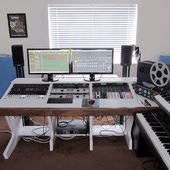-
Posts
305 -
Joined
-
Last visited
-
I think I found out why Workspaces was not working for me as expected. I use a couple of custom instances of Sonar, a simple one for composing with a single audio interface unit and a more complex one for mixing (six audio interfaces plus three external controllers). If you don't update these instances with the desired custom Workspace using 'Backup/Restore Settings', then the workspace which was last active when the settings were last saved, is loaded again, irrespective of 'apply workspace on project load' tick box. So now I know what to do it is working as desired.
-
Thanks. I don’t understand why the function “Apply Workspace on Project Load” doesn’t work as described. I can find no way to get it to load any other workspace (other than the preset ‘mix’) when I load a project. Maybe I am not doing things in the correct order?
-

Finding a project template using the Quick Start menu
norfolkmastering replied to norfolkmastering's topic in Cakewalk Sonar
Thanks, got it now! -
Yes I can recall my custom workspace from the list but it just will not load automatically next time I load the project.
-
I created a new custom Workspace, saved it and clicked the 'Apply Workspace on Project Load' Next time I load a project, it loads with the preset 'Mix' workspace. Happens every time! What am I doing wrong?
-
I read some of the Sonar documentation on creating templates and it indicated that a template would include the look of the workspace. So I tried it and it didn't! E.g. I don't normally use ProChannel so I deselected that as a Display element, then saved the template but ProChannel was displayed when I next loaded the template. Have I misunderstood?
-
If I record the plugin's otuput back into Sonar as a .wav file, then use that .wav file as the master LTC source (as a track in Sonar), then my tape machines won't lock to it. Also what I noticed is: You know if you set a SMPTE/MTC time Offset in Sonar then that offset is reflected in the main Sonar NOW time display. However that offset does not affect the time shown in the TimeCode plugin's time display. So it makes me wonder where they are deriving their NOW time signal from?
-
I know that the plugin designers used Tracktion Waveform for all their Timecode plugin testing work, so yes there must be some difference between how Sonar and Waveform is handling the plugin. As you'll see from an earlier post, I tried all of Mark's suggestions but so far with no result. Hopefully the plugin designers will look into this as you would reasonably have expected them to test the plugin with all the major DAWs, Sonar included!
-
Disabling PDC made no difference. Changing the Timecode plugin to a temp based effect made no difference. I checked and Tracktion is reporting the same output buffer size as Sonar. It has no way to measure total output latency sadly. I have suggested to the plugin designers that they download the free version of Sonar and test with their timecode plugin. Meanwhile I'll work with the .wav solution which seems fine.
-
Thanks for the things to try out which I’ll work through. The actual latency shouldn’t matter as long as it is constant while the plugin is generating the LTC. So I’m looking for something which is causing latency drift or jitter either in how the plugin is ‘locking’ to Sonar’s clock, or in how the plugin is sending the LTC to the ASIO driver. All my tests using a .wav LTC file show an extremely stable LTC signal which the tape machines are happy to sync to. I’ll keep testing but this does look like a plugin issue.
-
I checked the LTC signal level at the ASIO output and it was fine. The generated LTC audio is being recognised by my tape synchronisers and when I try to sync you can see the time difference (between the plugin generated LTC and the off-tape LTC) reducing towards zero. But it never quite gets there. If it was a fixed time difference (offset) between the two LTCs, it would still sync okay, so it is looking like some kind of jitter or drift in the plug-in’s ability to lock to the Sonar clock. As I said before, it works with Tracktion (which I think the develops used for testing) but so far not with Sonar.



